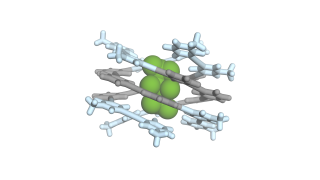
Doctoral Researcher Amar Raj investigates in his dissertation thesis excited-state proton transfer (ESPT) in photoacid-base complexes using femtosecond fluorescence upconversion broadband spectroscopy. The study focuses on how solvent polarity influences the dissociation of protonated species in binary organic solvents.
Understanding proton transfer in photoacid systems
The results show that ESPT proceeds through a rapid transfer within hydrogen-bonded complexes, outpacing solvent relaxation and requiring minimal structural reorganization. Following the initial proton transfer, contact ion pairs (CIP) are formed, which further dissociate into solvent-separated ion pairs (SSIP). Full dissociation into free ions occurs only in solvents with a dielectric constant above 10, emphasizing the role of the solvent environment in controlling reaction kinetics and product formation. Additionally, the study examined the transition from CIP* to SSIP* and found that this process is not driven by solvent polarity, suggesting that viscosity govern this transition in intermediate steps.
- These findings offer valuable guidance for optimizing solvent systems in photochemical and catalytic applications, explains Doctoral Researcher Amar Raj from the University of Jyväskylä.
Real-time electron transfer for viral RNA detection via func
Thesis also focused on development of a ratiometric fluorosensor named ‘Func sensor’ for detecting enteroviral RNA. The sensor integrates blue-emitting carbon dots, a red-emitting dye (ethidium bromide), and a specific oligonucleotide sequence to enable electron transfer-based detection.
- Time-resolved fluorescence measurements showed that the sensor’s performance relies on the close spatial arrangement of its components, which facilitates efficient electron transfer upon hybridization with the target RNA. Statistical analysis showed that the Func sensor had a linear detection range from 0.5 nM to 3 µM with a limit of detection of 270 pM in the presence of a standard sample containing the short sequence of target sequence, making it suitable for real-time monitoring of viral RNA release during infection, says Raj.
Raj demonstrated that Func sensor is capable of real-time in vitro detection of enteroviral RNA release from the capsid.
- This study links foundational photophysics with translational biomedical applications, highlighting how spectroscopic methods can inform the design of functional nanomaterials for biosensing, rejoices Raj.
Collaborative approaches to dye photophysics
As part of collaborative research efforts, Raj contributed to the development and validation of a three-angle fluorescence upconversion (3AM-FLUPS) strategy, which enhances spectral coverage and signal quality in ultrafast fluorescence measurements. His involvement helped demonstrate the method’s reproducibility across laboratories and its applicability to complex photophysical systems.
- Additionally, I participated in a study on semicroconaine dyes, investigating how molecular substituents and solvent viscosity influence deexcitation pathways. The findings suggest that these dyes, despite low initial fluorescence could be further engineered to responsive probes for sensing biomolecules, especially in environments where molecular motion is restricted, tells Raj.
Linking molecular dynamics to functional design
By combining ultrafast spectroscopy with targeted applications, Raj’s dissertation highlights how transient molecular events such as electron and proton transfer can be captured and understood in detail. This knowledge will help in designing functional materials and sensors that respond to molecular changes in real time.
- The research shows how ultrafast fluorescence can be used not just to observe, but to understand and engineer molecular behavior, says Raj.
MSc Amar Raj will defend his doctoral dissertation “Development and application of ultrafast fluorescence for studying chemical and materials systems” in the field of Ultrafast Spectroscopy at the University of Jyväskylä on Thursday 13.11.2025 at 12:00 in Ylistönrinne Campus in lecture hall KEM4. The opponent will be Professor Leif Hammarström (Uppsala University) and the custos will be Professor Mika Petterson (University of Jyväskylä). The defence will be held in English.
The dissertation “Development and application of ultrafast fluorescence for studying chemical and materials systems” is available online on the JYX publication archive: https://jyx.jyu.fi/jyx/Record/jyx_123456789_106611?sid=223217406







